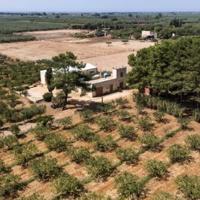Sicilian lemon producer Rosario Cognata is angered as his fruit is perishing because of the drought, while rainwater is being wasted just a few kilometers away into the sea.
The Trinita dam, constructed in 1959 in Castelvetrano in western Sicily, has never been tested or officially approved for use.
When the reservoir fills up with winter rainfall, the authorities release the water through the floodgates into a canal leading to the sea.
“The drought is due to lack of rain, but the mismanagement of water is not the responsibility of the farmers,” Cognata expressed while peering into the dam, revealing rusty steel tubes due to the low water level.
The dam was supposed to provide water for local irrigation networks, leading to the closure of farmers’ wells by the authorities.
However, the dam never received approval and was neglected over the years, leaving the infrastructure in a deteriorating state.
The faulty pipes have forced desperate farmers to dig unauthorized wells to make up for the water shortage.
Cognata points fingers at decades of ineffective local and government water management.
Italy’s main agricultural organization Coldiretti, to which Cognata belongs, also raises similar concerns.
– Outdated network –
Drought has always been a concern in Sicily, but the impact is worsening due to global warming.
This year, there has been a 350 mm decrease in rainfall compared to the average annual 750 mm, according to hydrology professor Leonardo Valerio Noto.
Noto, based at the University of Palermo, analyzes satellite images of Sicily’s 46 artificial reservoirs and notes that many are in critical conditions with some running dry, especially those serving urban areas.
The forecast for summer 2025 is even more dire, with withdrawals expected to surpass rainfall levels, causing drinking water shortages in some regions, particularly in the south.
Noto, like Cognata, criticizes the lack of investment in maintaining the water distribution network.
Although Italy is the EU’s leading country in water usage, it loses 42 out of 100 liters in distribution due to pipeline issues.
The wasted water could meet the annual needs of 43 million people, as reported by the National Institute of Statistics (Istat).
Sardinia and Sicily rank at the top for water loss percentages, with old pipelines contributing significantly to the problem.
The slow pace of pipeline renewal indicates a potential 250-year timeline to replace the entire network, at the current rate of progress.
– Young people are leaving –
The Sicily Region is committed to addressing the drought crisis with a 1.6 billion euro action plan in partnership with the government, aiming to reduce water losses.
However, local water management issues exacerbate the situation, like Agrigento missing out on funding due to procedural delays.
Cognata witnesses his lemon trees suffering on his estate in Campobello di Mazara, with significant loss of fruit due to the drought.
Lemons are prematurely ripening and drying out on the trees, reflecting the stresses caused by the water scarcity, leading to estimated losses of 30-40% for Cognata.
The water crisis not only jeopardizes livelihoods but also drives young people to leave rural areas, contributing to the depopulation trend seen in Sicily despite having a high birth rate.
gab/ide/yad





